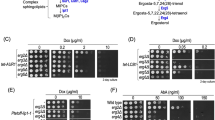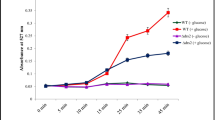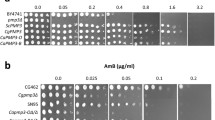Abstract
To understand the role of phospholipids on Cdr1p (drug exporter)-mediated drug resistance in yeast, the phospholipids biosynthesis genes PSD1, PSD2, CHO2, and OPI3 were deleted in a strain of Saccharomyces cerevisiae already overexpressing Cdr1-GFP of Candida albicans as a heterologous system. The effect of phospholipids biosynthesis gene deletion was analyzed on Cdr1p-GFP-mediated drug resistance as well as its localization. The results indicate that phospholipids biosynthesis disruption makes the cell sensitive to several drugs including fluconazole (FLC), with Δpsd1/Cdr1-GFP being worst affected. Interestingly, unlike sterols and sphingolipids, the localization of Cdr1p was unaffected by phospholipid biosynthesis gene disruption. Concomitantly, phospholipids mutants also showed an increase in reactive oxygen species (ROS) generation, as verified by fluorescence probe 2′,7′-dichlorodihydrofluorescein diacetate (DCFH-DA) method. In addition, the sensitivity of phospholipid mutants with FLC was found to be synergistic to ROS generation, resulting in further reduction of growth. Thus, this study proposes phospholipid biosynthesis as a novel target for antifungal therapy.





Similar content being viewed by others
References
Abe F, Hiraki T (2009) Mechanistic role of ergosterol in membrane rigidity and cycloheximide resistance in Saccharomyces cerevisiae. BBA Biomembranes 1788:743–752. https://doi.org/10.1016/j.bbamem.2008.12.002
Akins RA (2005) An update on antifungal targets and mechanisms of resistance in Candida albicans. Med Mycol 43:285–318. https://doi.org/10.1080/13693780500138971
Azad GK, Singh V, Mandal P et al (2014) Ebselen induces reactive oxygen species (ROS)-mediated cytotoxicity in Saccharomyces cerevisiae with inhibition of glutamate dehydrogenase being a target. FEBS Open Bio 4:77–89. https://doi.org/10.1016/j.fob.2014.01.002
Baker CD, Basu Ball W, Pryce EN, Gohil VM (2016) Specific requirements of nonbilayer phospholipids in mitochondrial respiratory chain function and formation. Mol Biol Cell 27:2161–2171. https://doi.org/10.1091/mbc.e15-12-0865
Bottinger L, Horvath SE, Kleinschroth T et al (2012) Phosphatidylethanolamine and cardiolipin differentially affect the stability of mitochondrial respiratory chain supercomplexes. J Mol Biol 423:677–686. https://doi.org/10.1016/j.jmb.2012.09.001
Brun S, Berges T, Poupard P, Vauzelle-Moreau C, Renier G, Chabasse D, Bouchara JP (2004) Mechanisms of azole resistance in petite mutants of Candida glabrata. Antimicrob Agents Chemother 48:1788–1796. https://doi.org/10.1128/AAC.48.5.1788-1796.2004
Carman GM, Han G-S (2009) Regulation of phospholipid synthesis in yeast. J Lipid Res 50:S69–S73. https://doi.org/10.1194/jlr.R800043-JLR200
Carman GM, Han G-S (2011) Regulation of phospholipid synthesis in the yeast Saccharomyces cerevisiae. Annu Rev Biochem 80:859–883. https://doi.org/10.1146/annurev-biochem-060409-092229
Chan EYL, McQuibban GA (2012) Phosphatidylserine decarboxylase 1 (Psd1) promotes mitochondrial fusion by regulating the biophysical properties of the mitochondrial membrane and alternative topogenesis of mitochondrial genome maintenance protein 1 (Mgm1). J Biol Chem 287:40131–40139. https://doi.org/10.1074/jbc.M112.399428
Chen Y-L, Montedonico AE, Kauffman S, Dunlap JR, Menn FM, Reynolds TB (2010) Phosphatidylserine synthase and phosphatidylserine decarboxylase are essential for cell wall integrity and virulence in Candida albicans. Mol Microbiol 75:1112–1132. https://doi.org/10.1111/j.1365-2958.2009.07018.x
Cortes-Rojo C, Calderon-Cortes E, Clemente-Guerrero M et al (2007) Electron transport chain of Saccharomyces cerevisiae mitochondria is inhibited by H2O2 at succinate-cytochrome c oxidoreductase level without lipid peroxidation involvement. Free Radic Res 41:1212–1223. https://doi.org/10.1080/10715760701635082
Gauthier C, Weber S, Alarco A-M et al (2003) Functional similarities and differences between Candida albicans Cdr1p and Cdr2p transporters. Antimicrob Agents Chemother 47:1543–1554. https://doi.org/10.1128/AAC.47.5.1543-1554.2003
Gietz RD, Schiestl RH, Willems AR, Woods RA (1995) Studies on the transformation of intact yeast cells by the LiAc/SS-DNA/PEG procedure. Yeast 11:355–360. https://doi.org/10.1002/yea.320110408
Gsell M, Mascher G, Schuiki I, Ploier B, Hrastnik C, Daum G (2013) Transcriptional response to deletion of the phosphatidylserine decarboxylase Psd1p in the yeast Saccharomyces cerevisiae. PLoS One 8:e77380. https://doi.org/10.1371/journal.pone.0077380
Gulshan K, Schmidt JA, Shahi P, Moye-Rowley WS (2008) Evidence for the bifunctional nature of mitochondrial phosphatidylserine decarboxylase: role in Pdr3-dependent retrograde regulation of PDR5 expression. Mol Cell Biol 28:5851–5864. https://doi.org/10.1128/MCB.00405-08
Hallstrom TC, Moye-Rowley WS (2000) Multiple signals from dysfunctional mitochondria activate the pleiotropic drug resistance pathway in Saccharomyces cerevisiae. J Biol Chem 275:37347–37356. https://doi.org/10.1074/jbc.M007338200
Henry SA, Kohlwein SD, Carman GM (2012) Metabolism and regulation of glycerolipids in the yeast Saccharomyces cerevisiae. Genetics 190:317–349. https://doi.org/10.1534/genetics.111.130286
Hitchcock CA, Barrett-Bee KJ, Russell NJ (1986) The lipid composition of azole-sensitive and azole-resistant strains of Candida albicans. J Gen Microbiol 132:2421–2431. https://doi.org/10.1099/00221287-132-9-2421
Jiang F, Rizavi HS, Greenberg ML (1997) Cardiolipin is not essential for the growth of Saccharomyces cerevisiae on fermentable or non-fermentable carbon sources. Mol Microbiol 26:481–491. https://doi.org/10.1046/j.1365-2958.1997.5841950.x
Khandelwal NK, Sarkar P, Gaur NA, Chattopadhyay A, Prasad R (2018) Phosphatidylserine decarboxylase governs plasma membrane fluidity and impacts drug susceptibilities of Candida albicans cells. BBA Biomembranes 1860:2308–2319. https://doi.org/10.1016/j.bbamem.2018.05.016
Kontoyiannis DP (2017) Antifungal resistance: an emerging reality and a global challenge. J Infect Dis 216:S431–S435. https://doi.org/10.1093/infdis/jix179
Loffler J, Einsele H, Hebart H et al (2000) Phospholipid and sterol analysis of plasma membranes of azole-resistant Candida albicans strains. FEMS Microbiol Lett 185:59–63. https://doi.org/10.1111/j.1574-6968.2000.tb09040.x
Maesaki S, Marichal P, Bossche HV, Sanglard D, Kohno S (1999) Rhodamine 6G efflux for the detection of CDR1-overexpressing azole-resistant Candida albicans strains. J Antimicrob Chemother 44:27–31. https://doi.org/10.1093/jac/44.1.27
Malinska K (2004) Distribution of Can1p into stable domains reflects lateral protein segregation within the plasma membrane of living S. cerevisiae cells. J Cell Sci 117:6031–6041. https://doi.org/10.1242/jcs.01493
Martin SW, Konopka JB (2004) Lipid raft polarization contributes to hyphal growth in Candida albicans. Eukaryot Cell 3:675–684. https://doi.org/10.1128/EC.3.3.675-684.2004
Moffett S, Brown DA, Linder ME (2000) Lipid-dependent targeting of G proteins into rafts. J Biol Chem 275:2191–2198. https://doi.org/10.1074/jbc.275.3.2191
Mollinedo F (2012) Lipid raft involvement in yeast cell growth and death. Front Oncol 2:1–15. https://doi.org/10.3389/fonc.2012.00140
Mukhopadhyay K, Kohli A, Prasad R (2002) Drug susceptibilities of yeast cells are affected by membrane lipid composition. Antimicrob Agents Chemother 46:3695–3705. https://doi.org/10.1128/AAC.46.12.3695-3705.2002
Niimi M, Wada S, Tanabe K et al (2005) Functional analysis of fungal drug efflux transporters by heterologous expression in Saccharomyces cerevisiae. Jpn J Infect Dis 58:1–7
Opekarova M, Robl I, Tanner W (2002) Phosphatidyl ethanolamine is essential for targeting the arginine transporter Can1p to the plasma membrane of yeast. BBA Biomembranes 1564:9–13. https://doi.org/10.1016/S0005-2736(02)00455-8
Opekarova M, Malinska K, Novakova L, Tanner W (2005) Differential effect of phosphatidylethanolamine depletion on raft proteins. BBA Biomembranes 1711:87–95. https://doi.org/10.1016/j.bbamem.2005.02.015
Pasrija R, Krishnamurthy S, Prasad T, Ernst JF, Prasad R (2005a) Squalene epoxidase encoded by ERG1 affects morphogenesis and drug susceptibilities of Candida albicans. J Antimicrob Chemother 55:905–913. https://doi.org/10.1093/jac/dki112
Pasrija R, Prasad T, Prasad R (2005b) Membrane raft lipid constituents affect drug susceptibilities of Candida albicans. Biochem Soc Trans 33:1219–1223
Pasrija R, Panwar SL, Prasad R (2008) Multidrug transporters CaCdr1p and CaMdr1p of Candida albicans display different lipid specificities: both ergosterol and sphingolipids are essential for targeting of CaCdr1p to membrane rafts. Antimicrob Agents Chemother 52:694–704. https://doi.org/10.1128/AAC.00861-07
Paul S, Schmidt JA, Moye-Rowley WS (2011) Regulation of the CgPdr1 transcription factor from the pathogen Candida glabrata. Eukaryot Cell 10:187–197. https://doi.org/10.1128/EC.00277-10
Prasad T, Saini P, Gaur NA, Vishwakarma RA, Khan LA, Haq QMR, Prasad R (2005) Functional analysis of CaIPT1, a sphingolipid biosynthetic gene involved in multidrug resistance and morphogenesis of Candida albicans. Antimicrob Agents Chemother 49:3442–3452. https://doi.org/10.1128/AAC.49.8.3442-3452.2005
Prasad R, Banerjee A, Khandelwal NK, Dhamgaye S (2015) The ABCs of Candida albicans multidrug transporter Cdr1. Eukaryot Cell 14:1154–1164. https://doi.org/10.1128/EC.00137-15
Rella A, Farnoud AM, Del Poeta M (2016) Plasma membrane lipids and their role in fungal virulence. Prog Lipid Res 61:63–72. https://doi.org/10.1016/j.plipres.2015.11.003
Robbins N, Caplan T, Cowen LE (2017) Molecular evolution of antifungal drug resistance. Annu Rev Microbiol 71:753–775. https://doi.org/10.1146/annurev-micro-030117-020345
Robl I, Grassl R, Tanner W, Opekarov M (2001) Construction of phosphatidylethanolamine-less strain of Saccharomyces cerevisiae. Effect on amino acid transport. Yeast 18:251–260. https://doi.org/10.1002/1097-0061(200102)18:3<251::AID-YEA667>3.0.CO;2-D
Sanglard D, Ischer F, Parkinson T, Falconer D, Bille J (2003) Candida albicans mutations in the ergosterol biosynthetic pathway and resistance to several antifungal agents. Antimicrob Agents Chemother 47:2404–2412. https://doi.org/10.1128/AAC.47.8.2404-2412.2003
Shingu-Vazquez M, Traven A (2011) Mitochondria and fungal pathogenesis: drug tolerance, virulence, and potential for antifungal therapy. Eukaryot Cell 10:1376–1383. https://doi.org/10.1128/EC.05184-11
Shukla S, Saini P, Smriti et al (2003) Functional characterization of Candida albicans ABC transporter Cdr1p. Eukaryot Cell 2:1361–1375. https://doi.org/10.1128/EC.2.6.1361-1375.2003
Singh A, Prasad R (2011) Comparative lipidomics of azole sensitive and resistant clinical isolates of Candida albicans reveals unexpected diversity in molecular lipid imprints. PLoS One 6:e19266. https://doi.org/10.1371/journal.pone.0019266
Singh A, Yadav V, Prasad R (2012) Comparative lipidomics in clinical isolates of Candida albicans reveal crosstalk between mitochondria, cell wall integrity and azole resistance. PLoS One 7:e39812. https://doi.org/10.1371/journal.pone.0039812
Singh A, Mahto KK, Prasad R (2013) Lipidomics and in vitro azole resistance in Candida albicans. OMICS 17:84–93. https://doi.org/10.1089/omi.2012.0075
Tsao S, Rahkhoodaee F, Raymond M (2009) Relative contributions of the Candida albicans ABC transporters Cdr1p and Cdr2p to clinical azole resistance. Antimicrob Agents Chemother 53:1344–1352. https://doi.org/10.1128/AAC.00926-08
Whaley SG, Berkow EL, Rybak JM, Nishimoto AT, Barker KS, Rogers PD (2017) Azole antifungal resistance in Candida albicans and emerging non albicans Candida species. Front Microbiol 7:1–12. https://doi.org/10.3389/fmicb.2016.02173
Xu X, Bittman R, Duportail G, Heissler D, Vilcheze C, London E (2001) Effect of the structure of natural sterols and sphingolipids on the formation of ordered sphingolipid/sterol domains (rafts): comparison of cholesterol to plant, fungal, and disease-associated sterols and comparison of sphingomyelin, cerebrosides, and ceramide. J Biol Chem 276:33540–33546. https://doi.org/10.1074/jbc.M104776200
Acknowledgments
We thank Prof. R. D. Cannon (University of Otago, New Zealand) and K. Natarajan (JNU, New Delhi) for providing us the plasmids and strains. We would like to acknowledge Dr. Garima Dalal (JNU, New Delhi) for her diligent efforts for language editing of this manuscript. The authors also thank Mr. Ashok Kumar Sahu from AIRF-JNU, for his support in confocal imaging.
Funding
This work was supported by the individual grant to R. Pasrija from University Grant Commission (F.No. 42-647(2013) SR); Department of Science and Technology (SERB/F/4213/2013-14), and Department of Biotechnology IPLS funding (BT/PR4329/INF’22/1444/2011) to Maharshi Dayanand University.
Author information
Authors and Affiliations
Corresponding author
Ethics declarations
Conflict of interest
The authors declare no potential conflict of interest.
Additional information
Publisher’s note
Springer Nature remains neutral with regard to jurisdictional claims in published maps and institutional affiliations.
Rights and permissions
About this article
Cite this article
Kundu, D., Hameed, S., Fatima, Z. et al. Phospholipid biosynthesis disruption renders the yeast cells sensitive to antifungals. Folia Microbiol 65, 121–131 (2020). https://doi.org/10.1007/s12223-019-00713-3
Received:
Accepted:
Published:
Issue Date:
DOI: https://doi.org/10.1007/s12223-019-00713-3




